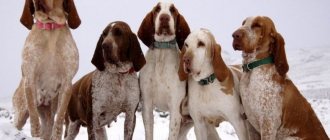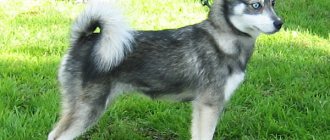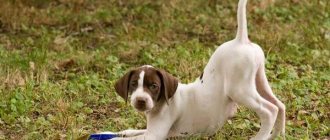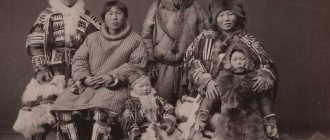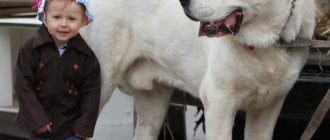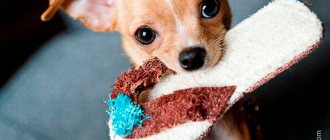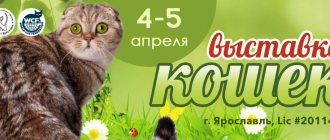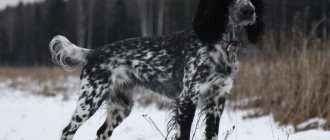The Maremmo-Abruzzese Shepherd Dog is a large and powerful ancient herding breed that has lived in Italy for a long time.
Representatives of the breed have snow-white fur . The peculiar character of these animals evokes respect and makes us treat snow-white giants with care.
The ability to make independent decisions has been cultivated for centuries, so maremmas are true partners, freedom-loving and independent. They can become a loyal friend, or they can be dangerous for the owner.
It is recommended to purchase such dogs only to experienced dog breeders who have knowledge about raising dominant, strong animals.
History of the breed
The Maremma is a true herding dog, whose ancestors came to Europe from the Tibetan peaks long before our era. Great Danes or steppe mastiffs, which accompanied the nomads, became the progenitors of most shepherd breeds.
The shepherd guarded the herds of the Roman nobility. In the found description of the dog, dating back to the 1st century AD, the Maremma is described in detail, indicating the white or yellowish color of the animal.
The light color made it possible to distinguish a dog from a predator from a distance in the dark.
The Romans put special collars , made of soft leather with sharp nails or spikes, for greater protection from wolves. The descriptions of that time directly indicate that the guard of a herd or flock is not supposed to be as light as greyhounds, but not as heavy as domestic guards. His weight should allow him to defeat a wolf and tirelessly run when driving a flock.
The Italians were and are extremely proud of their dog, and already at the beginning of the 20th century the first kennel club was formed, and in 1924 a breed standard was created. But it took another forty years for breeders to come to a consensus and find a compromise version of the name of the breed, and also create a refined standard.
The official date of international recognition of the breed is 1958. Since that time, maremmas have spread throughout the world, as their working qualities turned out to be extremely in demand.
The famous Konrad Lorenz conducted an independent study of the breed and found out that the Maremma-Abruzzese Shepherd Dog is the best guard dog .
General features and characteristics of herding dogs
Depending on their purpose, all four-legged shepherds are divided into 2 large groups: guard dogs and dogs that manage the herd. They differ from each other not only in their behavior, but also in their appearance:
- Sentinels. They are endowed with large dimensions (30-55 kg), hanging ears, white or gray color, allowing them to blend in with the herd. Focused on protection from predators and intruders. Livestock are treated like family.
- Managers. They have small sizes (10-20 kg), erect or semi-erect ears and spotted colors. Focused on working with people. They help him with grazing, pushing goats and sheep in the right direction by barking and biting their legs.
Regardless of their working skills, animals from both groups share a number of common characteristics. These include:
- dense wool that protects from getting wet, high and low temperatures;
- acute vision and hearing, helping to timely detect an enemy or an animal that has strayed from the herd;
- loyal attitude towards livestock;
- endurance, making long trips over rough terrain easier;
- developed pigmentation of mucous membranes, paw pads and eyelids, preventing burning under the scorching sun;
- high intelligence, simplifying training;
- fearlessness before the enemy and devotion to man.
IMPORTANT!
According to the FCI classification, herding and cattle dogs are included in group 1, as well as in section 3 of group 2.
The latter includes Swiss breeds, including the famous dog named Baron from the TV series “Happy Together”.
Character and temperament
Security qualities
The Maremma is a dog with a complex character, the characteristics of which are dictated by centuries of independent work as a shepherd and guard.
The ability to attack with lightning speed, secretly and silently is clearly illustrated by the following sketch: a maremma, protecting a flock of sheep from a bear , did not let the beast near for several hours. When he approached, the dog quickly jumped out from the thicket of the sheep, attacking the predator, then just as quickly disappeared among the flock, carefully watching the enemy.
Protecting the territory, the maremma vigilantly monitors all the boundaries of the site, trying to keep the largest possible area in sight. They are silent and reserved guards and excellent territorialists .
In a city where the pet is forced to be on a leash, he copes well with the duties of a protector, jumping towards the intruder’s face.
Maremma Abruzzese Sheepdog and man
In modern life, dogs try to behave in the same way with strangers and even with their owners, which often leads to unpleasant consequences. Almost all descriptions of the character of maremmas are silent about their desire to dominate the family, sudden and unpredictable aggression towards owners , and harsh attitude towards children.
The qualities that are so necessary for work become a source of danger for people who do not have sufficient experience in dealing with a large and strong dog.
Potential owners should be aware that dogs of this breed can be aggressive when trying to take food from them , lock them in an enclosure, or put them on a leash. Aggression manifests itself without warning, the dog can sit peacefully at the feet, allow itself to be stroked, and after the command “to its place”, attack the owner.
Moreover, the dog does not just beat with his fangs, trying to scare, but tears the soft tissues . This is often preceded by a difficult period of growing up, and isolated episodes of expression of dissatisfaction in the form of growling, separated by large periods of time.
Maremmas can behave like absolute leaders , not allowing children or weaker family members to enter certain rooms or sit on the sofa. This is always associated with improper behavior of the owners, and if the dog is not firmly put in its place, then it becomes dangerous. But, it should be noted that in case of danger, he will selflessly protect all household members.
Attitude towards children
Maremmas are not at all nannies for babies, as is written in most articles. These dogs can be a friend to younger family members only if the owner raises the puppy correctly.
The dog may perceive other people's children, as well as the child's friends who occasionally come into the house, as a potential threat. Many dogs are annoyed by the noisy running around and unceremoniousness of children.
Relationship with other pets
Most maremmas are not aggressive towards other animals ; they get along well with any breed of dog, especially if they grew up together. The shepherd nature of the dog makes him see pets as his property, which is inviolable.
Difficulties can only arise when feeding the dog: the Maremma is extremely sensitive to encroachments on her food, and immediately expresses aggression when trying to even get close to her bowl.
Dogs of this breed must be fed in isolation .
On the street, Maremmas behave calmly and are not aggressive towards other dogs, but males may try to measure their strength with rivals for a female. An interesting feature of the representatives of the breed is to vary their size: when attacked or threatened, the Maremma raises its fur so much that it appears huge, and a depressed dog decreases in size by half, folding in its place.
History of the origin and development of herding dogs
Shepherd dog breeds have been used to guard sheep and other farm animals since the beginning of cattle breeding. The domestication of wild artiodactyls was carried out by nomads traveling through Western Asia. In those days, a number of important requirements were put forward to four-legged defenders:
- presence of strength, courage and determination;
- big size;
- an innate distrust of strangers;
- readiness to defend the entrusted herd, regardless of the severity of the injuries received.
These qualities were used to repel the attacks of wolves, bears and other dangerous predators, as well as to prevent theft by people from warring tribes. The dogs bred by nomads quickly spread throughout Europe, where new varieties appeared as a result of crossing with local breeds.
With the development of agriculture and the growth of cities, the number of wild animals has sharply decreased. The share of land with crops has also increased, which has given rise to a new problem. Straying cattle began to cause serious damage to vegetables and fruits.
To the four-legged guard dogs we had to add those that guide the herd - smaller and more active shepherd dogs. They were entrusted with driving the flock and driving it into special enclosures, as well as searching for and returning animals that had strayed along the way.
Maintenance and care
Feeding
Maremmas eat simple food intended for large working dogs, be it natural or dry food. You can study the instructions for feeding a German Shepherd; these breeds have similar needs.
Large size with proportional addition during the growth period does not require high calorie food, as when growing Molossers. Chondoprotectors for the proper formation of joints and ligaments are necessary only during the period of active growth of the puppy.
Keeping a dog in an apartment
There is an opinion that the Maremma will suffer if kept in an apartment. This is not entirely true, because apartment maintenance poses difficulties primarily for the owners . This also applies to the dog’s profuse shedding twice a year, when the apartment is strewn with “poplar fluff,” and the peculiar aroma of dead meat in which these dogs love to roll. And the need for daily long walks, which the pet urgently needs.
Keeping it in the yard is ideal for maremma, which is not afraid of frost or hot weather. Thick coat and dense soft undercoat protect the dog from rain, cold and wind, and in summer they prefer to rest in the shade of trees.
Wool can clean itself, since the guard hairs have a smooth surface, and dirt quickly rolls off from them, only after drying slightly. You will have to brush your dog daily to prevent the thick, soft undercoat from becoming tangled. You can wash it rarely, before exhibitions or after heavy soiling.
Appearance and characteristics
This dog shows its hunting nature by its appearance. Slender figure with well-developed muscle definition. Long paws for long running are located strictly under the body, parallel to each other. Convex scruff. The back is straight and muscular, with a slight slope towards the tail. Developed breasts smoothly transition into a toned stomach. The high-set tail is docked in half. The head has an elongated skull, a clear contour, in females the nose is more pointed, in males there is a slightly “hump-nosed” profile.
The nose is often colored coffee or black, less often beige. The occipital protuberance is moderately developed. Noteworthy are the developed brow ridges and a small groove in the middle of the forehead. Drop ears with rounded ends, reaching the corners of the lips. The eyes are of medium size, the eyelids fit tightly, the iris is always dark brown, other colors are discarded. And the same proportional powerful jaws with a scissor bite. The dental formula is complete.
The dog is quite tall, 62-66 cm at the withers for males, 59-63 cm for females. The weight is not large: 25-32 kg and 22-27 kg, respectively.
There are 6 standard color options for the shorthaired pointer:
- completely coffee;
- coffee speckled or with small light spots on the limbs and chest;
- The roan is the color of dark coffee. The head is coffee-colored, the body is gray. specks or white spots are acceptable. The color is based on a combination of dark coffee and white.
- Roan is light, more white in color. Coffee head. Body with gray hair.
- Completely maroon.
- Black suit, with the same combinations;
The darker the shade, the better. The coat is thick, hard, about 1.5-2 cm long, dirt- and water-repellent, which makes cleaning the animal easier. When moving, the shorthaired pointer maintains an aristocratic profile, moves sweepingly, and when running, pushes off with its hind legs and throws out its front legs. Animals that amble are culled.
Training and walks
The Maremmo-Abruzzese Shepherd is a pleasure to train, although they can be stubborn at times. They grasp everything new and interesting on the fly, this is especially noticeable in the process of training small puppies. It is important to start socializing your pet as early as possible after quarantine.
The dog is put on a leash and led “in public” : through noisy streets, entering unfamiliar entrances, riding in a car and on public transport.
The earlier training begins, the fewer problems there will be with aggression towards the owner during the period when the dog’s character is developing. The dangerous period from 6 months to 2 years will pass painlessly, and the dog will obey the owner unquestioningly only if the owner constantly demonstrates his superiority.
The puppy must know that the owner is the main and all-powerful being in the world, and all members of the household are under his protection. Any growling or attempt to stand up with your chest to defend your piece of food or the right to lie on the master’s bed must be immediately and harshly suppressed .
The best way to demonstrate your superiority is to lift the dog by the skin, after which you need to press the dog to the ground and hold it until it begins to resist. It is clear that this is much easier to do with a puppy than with a forty-kilogram teenager.
Characteristics of the Komondor
The Komondor has a contradictory character. They are suspicious and wary of strangers. If the dog feels threatened, he will defend the territory and property of the owner. Representatives of the breed have highly developed herding and guarding instincts. They can even be aggressive with unfamiliar dogs, although they never attack first.
With its owner and family members, the Komondor is a calm, good-natured and affectionate pet. He loves children, is patient with them, will protect and shepherd them. Happy to support any active games. Can become a good nanny and bodyguard, feels responsible. But the dog is suspicious of other people's children; you should not leave the child's friends alone with him.
These dogs get along well with other pets only if they grew up together. They graze, protect and look after them. But they still strive to dominate and show their superiority.
Komondors are characterized by the following character traits:
- kind;
- devotees;
- reserved;
- affectionate;
- vigilant;
- brave;
- fearless;
- suspicious;
- independent;
- wayward.
Education and training
Without proper upbringing and socialization, a dog can become wayward and uncontrollable. Therefore, you need to start training her as early as possible. Komondors have a good memory, they are smart and quick-witted, and easily learn commands. But they don’t always follow them, because they are used to making decisions on their own. You can't turn a Komondor into a service dog. He will carry out the command if he deems it necessary. And first he will think about it and analyze it for a long time.
You need to find the right approach; inexperienced dog breeders may not be able to cope with such a dog. You need to communicate with the dog calmly and confidently. The Komondor will only obey the person who gains authority over him.
It is recommended to contact a canine specialist and take a course of OKD or UGS with your pet. But education and socialization must be done from an early age. You need to be persistent, strict, and you should not be allowed to break the rules of behavior. Professionals give the following parenting advice:
- it is impossible to put pressure on the Komondor and force him to do something, in response he will be even more stubborn;
- These dogs do not tolerate rudeness and physical punishment;
- classes should be conducted in the form of a game, they should be varied;
- you cannot repeat the same command many times - the dog will quickly get bored;
- Komondor obedience must be praised; affection and treats will also help reinforce correct behavior.
Health and duration
Like all representatives of large breeds, Maremmas live 10-12 years .
A huge advantage of these dogs is their excellent health and the absence of genetic diseases. There are practically no intrabreed diseases that are inherited; among the acquired ones, one can note diseases of the bones and joints due to improper rearing, as well as dermatoses.
Maremmas die the same way they live - making their own decisions about it. A dog that does not have any diseases simply stops eating and drinking and quietly fades away. Attempts to somehow prevent this are fruitless.
How to choose a pet
Mudi is a rare breed, not very common even in its historical homeland. Most nurseries are concentrated in Hungary, Finland, Sweden, the Czech Republic, Canada and the USA. In Russia, a limited number of breeders are engaged in breeding Mudi, so searching for a puppy can take a long time.
When choosing a Hungarian Cattle Dog, it is recommended to pay attention to:
- availability of documents of origin;
- appearance;
- behavioral characteristics;
- conditions of detention;
- health status.
On a note. Hungarian Cattle Dog puppies have a wavy coat from birth, which allows them to be distinguished from other breeds.
How much does it cost and where can I buy it?
You can buy a Maremmo-Abruzzese Shepherd Dog in a specialized nursery or from a private breeder. Puppies without documents are a rarity in this breed, since all matings take place through the official organizations of RKF or SKOR, there are puppies and adult dogs imported from abroad. A puppy without a pedigree is always a risk of acquiring a dog that bears little resemblance to a real maremma in appearance and temperament.
Puppy price: 30,000 – 80,000 rubles , it depends on the class of the parents and the exhibition prospects of the baby.
Pros and cons of herding dogs
The herding dog breeds listed above have a number of advantages. These include:
- beautiful physique;
- thick and warm coat, suitable for keeping in an enclosure;
- a weak hunting instinct, which makes it easier to live together with other animals - and some “shepherds” even look after their smaller brothers;
- an innate distrust of strangers, important for protecting home and property;
- unquestioning devotion to the owner, excluding disobedience.
There are also disadvantages. Many four-legged shepherds are very massive. In an ordinary city apartment they will be cramped and uncomfortable, and because of their strong barking they can cause discontent among neighbors.
Particular attention should be paid to increased activity. Shepherd dogs are suitable for owners who love sports and travel. If you value peace of mind and prefer not to leave the house again, then it is better not to buy such a pet.
Breed photo
A selection of photos of maremmas.
How to buy a Komondor puppy
In Russia, representatives of this breed have been known since the second half of the 20th century. But it is not very popular and few in number. To buy a purebred puppy, you need to contact a nursery. The cost of representatives of the breed is quite high, which is explained by its rarity. In Moscow, Komondors cost 50-80 thousand rubles.
When buying a puppy, you need to take into account that its coat should be soft and curly. You need to pay attention to the position of the limbs, fatness, bite. There should be no crease on the tail, the eyes should be clean, without discharge. When choosing a gender, you need to take into account that males are more aggressive and prone to dominance. Bitches are more suitable for a family with a child, they are affectionate and flexible.
The photo shows what the puppies look like:
The video complements the characteristics of the breed:
Video: My pet: Komondor
Video: Komondor (Hungarian Shepherd)
Video: Komondor / Hungarian Shepherd | Owner review | Breed Review | The most unusual herding dog
The Hungarian Shepherd is an excellent family dog and a devoted companion. She becomes strongly attached to her owner and can become a best friend, a reliable security guard and bodyguard.
Historical reference
This amazing dog has lived on Hungarian soil for thousands of years. Several interesting legends are associated with the origin of the breed. According to one of them, the Komondor breed is the result of crossing wolves and sheep. A more realistic version, based on scientific facts, says that the Hungarian Shepherd Dog arose as a result of a mixture of wolves and herding dogs.
The breed received its first name “Hungarian Shepherd” as a result of the fact that it accompanied the Hungarian tribes in their nomadic life. The name Komondor comes from the Italian “cane commodore”, which means “king dog”. The animal received such a majestic nickname due to its large size, aristocratic manners and unusual coat. Also related to the Hungarian Shepherds is the Puli dog breed.
The first Komondors served as shepherds. They were perfect for this role, being brave, resilient, decisive and capable of defending themselves from the enemy and preserving the owner’s property. Thanks to their appearance, they blended in with a herd of sheep and suddenly jumped out in front of the nose of an approaching wolf, which confused him.
The Komondor breed is quite common these days, especially in the United States of America.
Character, abilities, skills
Protecting the herd and property entrusted to him, the Komondor shows unshakable courage. His attack is silent and courageous. No alien creature can set foot on the area entrusted to him.
The Komondor is very suspicious. During the day, he willingly spends time in a lying position, which allows him to survey the entire area; at night, he is constantly on the move.
Hungarian Shepherds are often chosen as pets by people living in private homes.
The Komondor has proven itself to be an excellent watchdog.
Komondors are divided into two psychological types: freedom-loving and dependent on human attention. In early childhood, the breeder notices the peculiarity of each puppy in this regard and, in accordance with the purpose of purchasing the puppy, recommends a specific baby to the future owners.
The Hungarian Komondor dog becomes a very friendly and good-natured dog when it understands that the family and owner are safe.
She is very loyal to her owner. This also applies to freedom-loving breed types. The purpose of the Komondor requires him to have some independence and make his own decisions, so notes of independence creep into the pet’s character.
Proper socialization and competent training are necessary to shape the character of the Hungarian Shepherd. In some cases, it shows stubbornness and strives to gain the upper hand over the owner, so the owner must engage in education from early childhood, teach commands with gestures and show the animal who is really in charge.
The Komondor dog breed needs a lot of physical activity. If the owner does not satisfy this need, he will receive a negative response from the animal. The Komondor is a very strong dog, and when dying of boredom, it can create real chaos in the house.
Basic pros and cons
Pros:
- excellent security guard;
- strength and endurance;
- excellent herding qualities;
- calm temperament, good nature;
- treat children well;
- easy to train;
- devotion to the owner and family.
Minuses:
- difficult coat care;
- desire to dominate;
- suspicious attitude towards strangers (this can also be considered a plus).
The Komondor is an original breed with its own peculiarity in the form of an unusual coat. It has its merits, and if the future owner is willing to devote a lot of time to raising, training the dog and caring for its unique coat, he may think about purchasing a puppy.
Additionally, check out the video that describes the Komondor breed:
